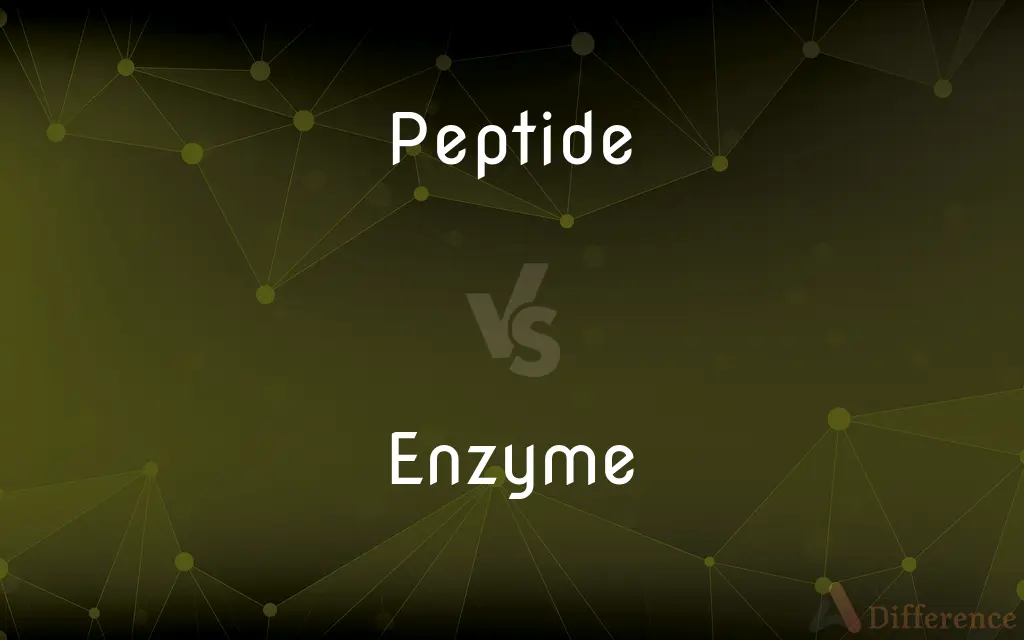Peptide vs. Enzyme — What's the Difference?
Edited by Tayyaba Rehman — By Maham Liaqat — Updated on April 18, 2024
Peptides are short chains of amino acids linked by peptide bonds, typically not exceeding 50 units, whereas enzymes are proteins that catalyze biochemical reactions and can consist of one or more peptide chains.

Difference Between Peptide and Enzyme
Table of Contents
ADVERTISEMENT
Key Differences
Peptides are short sequences of amino acids, generally containing between 2 to 50 amino acids. On the other hand, enzymes are larger, complex proteins that can be composed of one or more peptide chains and often contain more than 50 amino acids.
Peptides primarily serve as signaling molecules or structural components in cells, influencing various biological processes by interacting with receptors or other cellular structures. In contrast, enzymes act as catalysts in biochemical reactions, speeding up processes without being consumed, essential for metabolic pathways.
The synthesis of peptides is straightforward, often occurring through direct synthesis without the need for a complex folding process. Whereas, enzyme synthesis is more involved, requiring transcription and translation processes, followed by proper folding and sometimes post-translational modifications to become active.
Peptides do not possess catalytic activity; their function is generally limited to their ability to bind to other molecules and affect function. Conversely, enzymes are defined by their catalytic activity, which is fundamental to their role in facilitating chemical reactions in biological settings.
While peptides can be synthesized artificially with relative ease for use in research and therapy, producing enzymes synthetically is more complex due to their larger size and the necessity for precise three-dimensional structures.
ADVERTISEMENT
Comparison Chart
Size
Typically 2-50 amino acids
Often more than 50 amino acids, can be much larger
Role in Biology
Signaling, structural
Catalytic, facilitating biochemical reactions
Synthesis Complexity
Simple synthesis, no complex folding required
Complex synthesis, folding, and post-translational modifications
Catalytic Activity
None
Fundamental characteristic
Synthetic Production
Relatively easy to synthesize artificially
Complex due to size and structural specificity
Compare with Definitions
Peptide
Peptides can act as hormones, transmitting signals throughout the body.
Glucagon, a peptide hormone, plays a crucial role in maintaining blood glucose levels.
Enzyme
A protein that catalyzes chemical reactions without being consumed or altered.
Amylase is an enzyme in saliva that breaks down starch into sugars.
Peptide
A molecule consisting of two or more amino acids linked by peptide bonds.
Insulin, a hormone important for glucose regulation, is a peptide formed from 51 amino acids.
Enzyme
Enzymes can be highly specific to substrates, reacting with particular molecules.
The enzyme lactase specifically catalyzes the hydrolysis of lactose into glucose and galactose.
Peptide
Peptides serve as antibiotics, providing defense mechanisms for organisms.
Polymyxin B is a peptide used to combat bacterial infections.
Enzyme
Enzyme inhibitors can regulate or inhibit enzymatic activity, used in medicine.
ACE inhibitors are used to lower blood pressure by inhibiting the angiotensin-converting enzyme.
Peptide
In research, synthetic peptides are used to study protein functions and interactions.
Researchers use synthetic peptides to block protein-protein interactions in cancer studies.
Enzyme
Enzymes are crucial in metabolic pathways, facilitating reactions at necessary speeds.
Hexokinase catalyzes the first step in glycolysis, converting glucose to glucose-6-phosphate.
Peptide
Peptides can modulate immune responses, useful in vaccine development.
Vaccine developers use peptides to elicit targeted immune responses against specific pathogens.
Enzyme
Some enzymes require cofactors, non-protein components, to be active.
Many enzymes in the electron transport chain require iron-sulfur clusters to function.
Peptide
Peptides (from Greek language πεπτός, peptós "digested"; derived from πέσσειν, péssein "to digest") are short chains of between two and fifty amino acids, linked by peptide bonds. Chains of fewer than ten or fifteen amino acids are called oligopeptides, and include dipeptides, tripeptides, and tetrapeptides.
Enzyme
Enzymes () are proteins that act as biological catalysts (biocatalysts). Catalysts accelerate chemical reactions.
Peptide
Any of various natural or synthetic compounds containing two or more amino acids joined by peptide bonds that link the carboxyl group of one amino acid to the amino group of another.
Enzyme
Any of numerous compounds that are produced by living organisms and function as biochemical catalysts. Some enzymes are simple proteins, and others consist of a protein linked to one or more nonprotein groups.
Peptide
(organic compound) Any of a class of organic compounds consisting of various numbers of amino acids in which the amine of one is reacted with the carboxylic acid of the next to form an amide bond.
Enzyme
(biochemistry) A globular protein that catalyses a biological chemical reaction.
Peptide
(chemistry) The peptide bond itself.
Enzyme
(Christianity) leavened bread, as opposed to azyme
Peptide
Amide combining the amino group of one amino acid with the carboxyl group of another; usually obtained by partial hydrolysis of protein
Enzyme
A protein produced by a living organism, capable of catalyzing a chemical reaction. Almost all processes in living organisms require some form of enzyme to cause the reactions to occur at a rate sufficient to support life. There are a very wide variety of enzymes, each specifically catalyzing a different chemical reaction, the sum of which cause the bulk of the physiological changes observed as life processes. Enzymes, like most proteins, are synthesized by the protein-synthetic mechanism of the living cell, at special sites on ribosomes, using the genetic information in messenger RNA transcribed from the genetic instructions stored as nuleotide sequences in the DNA (or in some viruses, the RNA) of the genome. Some examples of enzymes are: pepsin, diastase, rennet, DNA polymerase, invertase, glucose oxidase, protease, and ribonuclease. There are many other types of enzyme.
Enzyme
Any of several complex proteins that are produced by cells and act as catalysts in specific biochemical reactions
Common Curiosities
How do enzymes catalyze reactions?
Enzymes catalyze reactions by lowering the activation energy, making the reaction proceed faster than it would without the enzyme.
Can peptides be synthetic?
Yes, peptides can be synthetically produced for various applications, including research and therapeutic use.
What defines a peptide?
A peptide is defined as a short chain of amino acids linked by peptide bonds, generally not exceeding 50 units.
Do peptides have catalytic functions?
Peptides generally do not have catalytic functions; their roles are mainly structural and signaling.
Are all enzymes proteins?
While most enzymes are proteins, some RNA molecules called ribozymes also exhibit catalytic properties.
How are enzymes named?
Enzymes are often named based on the reaction they catalyze, typically ending in '-ase'.
Are peptides found in all living organisms?
Yes, peptides are present in all living organisms, serving various biological functions.
Can enzymes be inhibited?
Yes, enzymes can be inhibited by specific molecules that decrease or block their catalytic activity.
What determines enzyme specificity?
Enzyme specificity is determined by the enzyme's active site, where only specific substrates can bind.
What are enzyme cofactors?
Enzyme cofactors are non-protein molecules required by some enzymes to assist in catalytic activity.
What are common uses of enzymes in industry?
Enzymes are widely used in industries such as pharmaceuticals, biotechnology, and food processing.
How are peptides related to proteins?
Peptides are essentially small proteins or segments of proteins, typically comprising fewer than 50 amino acids.
What is the role of peptides in the immune system?
Peptides play roles in the immune system, often acting as signaling molecules that regulate immune responses.
What are therapeutic applications of peptides and enzymes?
Therapeutic applications of peptides include hormone therapy and vaccine development, while enzymes are used in treatments like enzyme replacement therapy.
Can peptides form structures like proteins?
While peptides can form secondary structures, they are generally too short to form complex tertiary structures like proteins.
Share Your Discovery

Previous Comparison
Agate vs. Marble
Next Comparison
Hyperbolic vs. HyperboleAuthor Spotlight
Written by
Maham LiaqatEdited by
Tayyaba RehmanTayyaba Rehman is a distinguished writer, currently serving as a primary contributor to askdifference.com. As a researcher in semantics and etymology, Tayyaba's passion for the complexity of languages and their distinctions has found a perfect home on the platform. Tayyaba delves into the intricacies of language, distinguishing between commonly confused words and phrases, thereby providing clarity for readers worldwide.















































